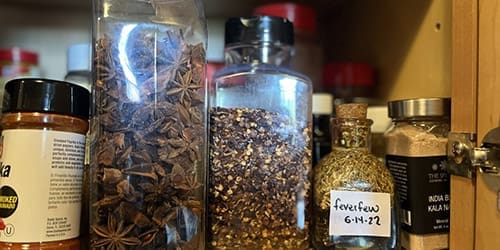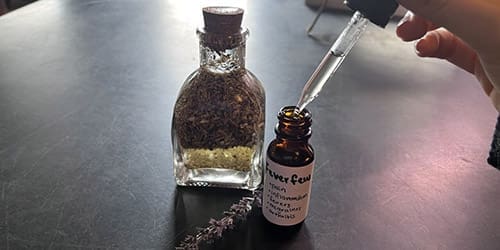If you’re looking for a versatile painkiller that you can make yourself and have on hand when SHTF, consider making a feverfew tincture. Feverfew is a widely available perennial in the daisy family that you can grow on your own or find in the wild.
Making a tincture out of feverfew flowers provides you with a remedy that can be used in place of a painkiller that you may not have access to during an emergency situation.
Not to mention, feverfew has fewer side effects than pharmaceutical painkillers, which can be addictive and harmful to your health.
What Is Feverfew?
Feverfew, Tanacetum partheniu, is a plant that is native to southeastern Europe and the Balkans, although today you can find it almost everywhere in the world, including all of Europe, North America, Asia, and Australia.
It is a member of the daisy family and is sometimes referred to as wild chamomiles. Feverfew often grows alongside roads and near wooded areas. You can recognize it by its small white flowers and yellow-green leaves that are arranged alternately along the round stem.

The stems may reach a height of about three feet and are topped with flowers that bloom towards the end of the summer season. The flowers are smaller than daisies and have yellow centers consisting of tightly bunched tubular florets surrounded by creamy white petals.
Feverfew has been used for centuries to treat pain and other issues. There is evidence that Ancient Greek and Roman physicians used it for a wide range of medicinal purposes.
⇒ Buy Here Feverfew Seeds And Other Seeds You Need To Start Your Medicinal Herb Garden
Feverfew Benefits
In the 1600s, feverfew became a common remedy for migraines and headaches. Used regularly, feverfew has been shown to reduce the frequency and severity of migraines even when no other remedy was able to help.
In the 1700s it was being used for everything from opium overdose recovery to the treatment of fevers. It was believed to aid in digestive issues, childbirth, alcohol withdrawal, sciatica, and even mild depression.
One thing that it never failed to help was pain – regardless of its origin. Since then, there has been a lot of research done on feverfew to understand how it works. Research shows that it’s great at reducing inflammation, relieving spasms, dilating blood vessels, reducing fever, and reducing pain from migraines, arthritis, toothaches, and periods.
Feverfew Painkiller Tincture Recipe
Feverfew can be used in the form of tea, poultice, or a tincture. We love making a tincture with it because it’s easy. The resulting tincture is very potent and doesn’t take up much space while providing us with a powerful long-lasting remedy.
Making a tincture requires minimal supplies. Here is everything you’ll need:
- small glass jar (4 oz.) with a lid
- brown glass tincture bottle with a dropper
- at least 2 oz. of feverfew, dried works best
- 80 proof alcohol (e.g. vodka)
- cheesecloth or fine strainer

When it comes to the supplies, work with what you have around the house. For example, we didn’t have our usual 4 oz. mason jars available, so I used another jar that had a cork lid. All that matters is that the jar is made out of glass and can fit your ingredients.
As far as the alcohol goes, you can use any 80-proof alcohol. Vodka is versatile and works well with all plants. You can buy dry feverfew from a supplier to save you some time.
However, there’s nothing more satisfying than foraging or growing your own feverfew for this recipe.
If you choose to go that route, make sure to harvest it when it is in full bloom, late summer. Cut the stems about one-third of the way down and hang them upside down in a paper bag in a cool and dry place.
After a few weeks, the herbs should be dry enough to go into your tincture.
Directions:
Once you have all of your supplies, follow the steps below. The total time to make a feverfew tincture is 4-6 weeks, but you’ll only spend about 10 minutes of active work.
1. Start by placing your dried feverfew herbs into your jar. Make sure to pack the dry material well so that you can fit more.

2. Once the jar is just over halfway full, pour your alcohol over it gently, all the way to the top of the jar.

Gently mix the herbs and the alcohol. You can seal the lid and shake it or use a spoon to mix everything together before sealing it.
3. Put today’s date on the jar so you know when you prepared it. Now place it in a cool dark place. It will live here for the next 4-6 weeks. Your herbs cabinet is a perfect place for it.

4. After 4-6 weeks, your tincture is ready! The only thing left to do is to strain it and pour it into a tincture bottle.
We use brown glass tincture jars because they protect the contents from sunlight, extending their effects much longer.

You can use a cheesecloth or a fine strainer to pour the contents of the jar into a tincture bottle.
Make sure to mark the tincture bottle to make it clear what is in it and when to use it. This little bottle can fit into your bug-out bag, car, or medicine cabinet. It will last you years.
How To Use Your Feverfew Tincture
Whenever you’re feeling like you need to use your tincture for your pains, aches, and fevers, start with a few drops under the tongue.
Simply fill the dropper with the tincture and drop it directly in your mouth.
Feverfew tends to have a bitter flavor, so if that bothers you, you can add it to your food or drinks to mask the flavor. If you need more, feel free to increase your dose up to two full droppers twice a day.
This article first appeared here.
You may also like:
If You See This Plant in Your Backyard, Burn It Immediately! (Video)













